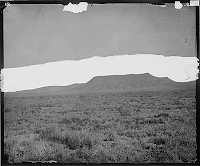 [Ed.—In this excerpt, the travelers are back in the Hualapai Valley, with some contradictory information. The book about Henry Martin Tanner is an unedited manuscript that was never formally published, so there are some inconsistencies that might have been edited out of a published book.]
[Ed.—In this excerpt, the travelers are back in the Hualapai Valley, with some contradictory information. The book about Henry Martin Tanner is an unedited manuscript that was never formally published, so there are some inconsistencies that might have been edited out of a published book.]Several of the Hunt girls have left accounts of the journey, based on diaries kept on the trip. It seems that the company was divided into three groups on account of the scarcity of water. Bushmans and Manasseh Blackburn [1852-1878] were in the lead, followed by the Westovers and their company and last were Hunts and Tanners.
The diary of May Hunt Larsen [1860-1943; she is mentioned in John Morgan's diary] gives a day by day account of the movements of the latter group.
In the Walaipi [Hualapai] Valley they rested their animals as the water and grass were fairly good. [Didn't he just say in the last post that there was no water in the Hualapai Valley?] "Here one of Henry's mares died of distemper."
At Fortoon Spring [can't find anything under this name or under "Fortune Spring"] an ox in the Hunt team gave out and had to be left. "There was very little grass here so we did not expect to see him again."
On April 7th they came to Young Springs where they noted "a great many Indians but very little water. There being only two little springs, had it not been for a ranch (Peach Springs) three miles off the road on the left, the animals would have suffered greatly for water. We unloaded our light wagon and took the barrels and everything that would hold water up to be filled. Here our old Broad, our trusty near wheel ox, got down on a rocky hill and could not get up so we sold him to the Indians to eat. This left only two oxen in the team and we had to work cows in the place of the dead oxen."
Excerpt from George S. Tanner, Henry Martin Tanner: Joseph City Arizona Pioneer, 1964, pp 16-17. Some minor editing corrections made to the text.
Part 1
Part 2
Part 3
Part 4
Part 6
Part 7
Photo of "Lower Mesa near Young Springs" from the Wheeler Survey (1871) of the United States Army Corps of Engineers. The collection is in the Smithsonian and is made available to the public by the University of Maryland Institute for Advanced Computer Studies. Series: Geographic Explorations and Surveys West of the 100th Meridian. There are some very interesting photos in this collection of the arid borderlands in the Utah-Colorado-Arizona-New Mexico-Nevada area.
No comments:
Post a Comment